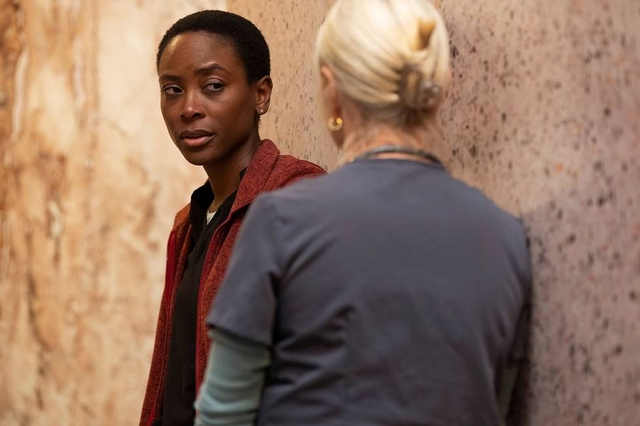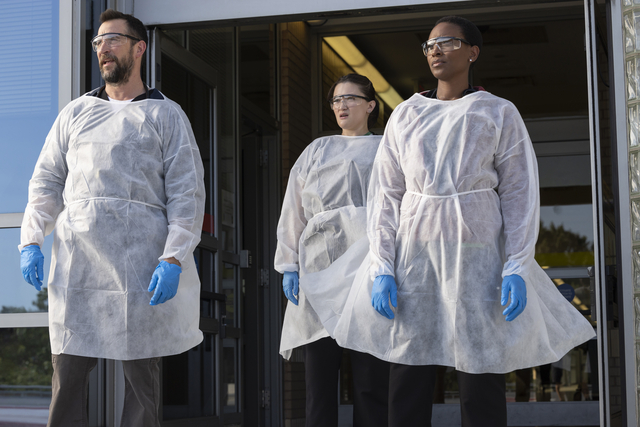Created by R. Scott Gemmell (ER, JAG, NCIS: Los Angeles), The Pitt is a medical procedural television show set in the fictional Pittsburgh Trauma Medical Hospital (The Pitt) over a continuous course of fifteen hours. It stars Noah Wyle, Tracy Ifeachor, Patrick Ball and Katherine LaNasa as series regulars. Writer/ producer Joe Sachs, who has worked with Gemmell since ER, is also an emergency physician in real life. He shares his experiences on working on The Pitt with Creative Screenwriting Magazine.
Sachs states that his medical background adds so much to The Pitt rather than hinders it because he might be too close to the material. “We try to keep it real, we try to keep it current, and we try to keep it accurate,” declares Sachs. If anyone pitches an idea for a medical storyline, he will nix it if it’s inaccurate or inauthentic. That said, an initially-rejected idea, might lead to a better idea that can be used. Sachs works works three other physicians on story development which allows The Pitt to explore rarely-seen or unusual storylines that no-one in the writers’ room would have otherwise conceived.
Sachs is also mindful that The Pitt is a television drama that must ultimately serve the audience. Although the medical storylines are accurate, the writers fold in dramatization and the emotionality of the characters above all else.
“At the most basic level we never start with the medicine. We always start with the dramatic needs of the character which sends me searching for the right medical case that dramatizes them,” continues Sachs.

Joe Sachs
The writer references an episode where medical student Dr. Victoria Javadi’s (Shabana Azeez) mother, attending senior surgeon Dr. Eileen Shamsi (Deepti Gupta), inappropriately calls her “honey” and belittles her in front of their colleagues. Sachs wondered how this unprofessional dynamic can unfold in the writers’ room where the student one-ups her superior. The writer came up with the idea of a Black Widow spider bite to illustrate. The abdominal muscle spasms following such a bite mimic a perforated appendix or bowel and patients have been given emergency surgery to treat those rather than the spider bite.
So Dr. Javadi, in her beginner’s mind, saw beyond the immediate symptoms and went back to the patient and found out she was moving wood from a wood pile and a splinter landed in her foot. The doctor looked in the patient’s shoe and found a spider. Sachs quotes this as a perfect example of the drama driving the medicine.
Managing Pacing And Storylines in The Pitt
Writing an entire season spanning 7:00am to 9:00pm on a single day to mimic a typical ER shift is a tall order which The Pitt handily fulfils. The series runs at a steady clip to capture the velocity of a typical ER department. Joe Sachs doesn’t consciously think too much about the speed of each episode or having slower, reflective moments. He feels out the episode.
“The formula of the show is that there is no formula,” quips Joe.
In traditional medical dramas, there’s an A story and B story in each episode with a minor C story that spans most of the season along with a case of the week woven in. The Pitt contains stories that run over eight hours to emulate actual emergency room cases, but many run shorter. The Pitt deviates further from episode counts at times. “In some of the stories you’ll see a random person in the waiting room who you think is just an extra and three hours later they become a very important story line.” The emergency department in The Pitt contains 27 rooms, there are 21 patients waiting to go upstairs to surgery, and there’s a waiting room with 50 patients. “Things are always happening and we like to mix it up.”
Some storylines are wrapped in one episode in just a few beats. An example is when a mother with a crying, inconsolable baby is admitted. The baby has a “hair tourniquet” where a mother’s hair wraps around her baby’s pinky toes and cuts off the circulation. This feeds into the attending Dr. Collins’ (Tracy Ifeachor) situation of being pregnant and also anxious about being a mother. It affects how she interacts with the patient. On the other hand, the other attending physician Dr. Melissa King (Taylor Dearden) is much younger and not as well-versed in the subtleties of dealing with mothers and bombards the patient with possible extreme diagnoses for her baby such as meningitis and pneumonia.

Dr. Heather Collins (Tracy Ifeachor) & Nurse Dana Evans (Katherine LaNasa) Photo courtesy of MAX
The fentanyl overdose of the college student storyline stretches over eight episodes culminating in the parental consensus for organ donation and the ‘honor walk’ at the end of episode eight.
The writers decide what beats are required to tell each story and how they might play over the course of a 15-hour day rather than choose how many episodes it should cover.
The medical consultants on The Pitt indicated that every situation in an emergency department is in a constant state of flux in terms of urgency. Even the simple task of prioritizing medical necessity is difficult because there are ten people that need equal attention at once.
How Much Story Is In The Pilot Episode?
The creator of The Pitt are mindful of not only the length of each storyline, but also the number. “When the network read the pilot episode they balked at meeting thirty-six patients. How are they supposed to know who to care about?” Sachs explained that that was the whole point – to get the audience used to the hectic environment.
“You had to get used to the rhythm, the complexity, the lay of the land, who these doctors were, the waiting room, walking around and seeing patients boarding and understanding the toll of seeing so many patients came by,” he elaborates.
The network wanted a “one and done pilot episode with a victory at the end.” The Pitt fulfilled this note with a storyline about a triathlete Otis (Alfonso Caballero) with kidney damage and high potassium levels needing to have his heart shot. “He was all tucked in by the end of the episode.” Additional storylines include the arrival of a mother Theresa (Joanna Going) and her concerns for her high school son David (Jackson Kelly) after discovering his potential for violence against women in his notebook.
There is also a drunk patient Louie (Ernest Harden Jr.) who sleeps off his drunken bender in the pilot. He’s discharged and returns in Episode 8 and becomes an important part of Dr. Trinity Santos’ (Isa Briones) and Dr. Patrick Langdon’s (Patrick Ball) lives.
Developing Character In A 15 Hours Shift
Since many television shows take place over a few weeks or months, there is scope for character growth. Since The Pitt unfolds over fifteen hours, there isn’t scope for extended character arcs. Instead, the show explores how the characters respond under pressure and the emotional tolls the job has on their personal lives. As the day progresses, we find out a little more about them.
“We reveal in very subtle ways that Mel has a sister who’s neurodiverse and she is her caregiver. We unveil the mother-daughter relationship with Dr. Javadi and Dr. Shamsi. We find out that Dr. McKay (Fiona Dourif) is a single mother trying to help her son. She wears an ankle monitor for some reason,” explains Sachs.
We give a peek into people’s lives as they manage a hectic work day
Dr. Michael “Robby” Robinavitch (Noah Wyle) is the senior attending physician who runs the department and also suffering from the PTSD effects of the COVID pandemic. We meet him on the anniversary of the death of his mentor Dr. Adamson through a variety of intensifying flashbacks. These depictions are accurate as many attending doctors from the pandemic are still acknowledging and managing the trauma of dealing with patients they lost.

Dr. Victoria Javadi (Shabana Azeez), Dr. Robby (Noah Wyle) & Dr. Samira Mohan (Supriya Ganesh) Photo courtesy of MAX
The entire department looks up to the stoic Dr. Robby for expertise and guidance. He’s deeply flawed, troubled and in denial over his COVID trauma. He hides his panic attacks as he pushes through his work day. We soon see cracks in his armor as the season progresses. It becomes apparent that he needs help. He can’t just be the helper.
Which Is Joe Sachs’ Favorite Episode?
Episode 8: 2:00pm, which he also wrote.
This episode deals with the loss of the little girl Amber (Hadley Smith) who drowned in the backyard pool after jumping into the pool to save her big sister. It deals with the honor walk for the organ donor and it also had an amazing story about the Freedom House Ambulance Service. In the 70s a group of young black men were trained to be what we now call ‘paramedics’ – which eventually became emergency medicine and pre-hospital care.
Robby speaks with such tenderness to the parents of a dying girl who cannot be resuscitated. Melissa also speaks to the little sister who lost her big sister with the teddy bear.
“I like emergency medicine for two reasons: Number one you’re presented with a problem that you have to solve. There’s the cognitive aspect. You have to think and you have to figure out the diagnosis. Number two: you have to have amazing empathy in terms of dealing with patients and their families on the worst day of their life.”
“You are a stranger when a when an elderly family member is dying of cancer. The disease process has been going on for months and there is this relationship with the primary caregiver. The emergency physician is a total stranger who has to walk in the door and establish instant rapport… and that is the challenge.”
